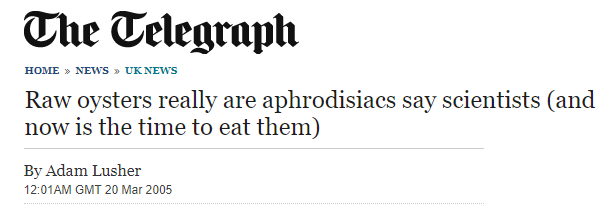Courting RitualsIn ancient times, love and marriage was much more crude. Women would be kidnapped or attacked and forced into marriage. Long term relationships were almost never based on romantic love, but for property, wealth and alliances. Women who did not conform to this norm were cast to the fringes of society.
We are fortunate to be much more enlightened today.
Chapter title from the life manual “The Telegraph”, circa 2005.
Numerous texts from the early 21st century reference “oysters” as an aphrodisiac, as seen in this chapter title (pictured below, left) from the popular life manual “The Telegraph”. This blue rectangular card was used by men to give to women to show they were interested in a sexual liaison. If the woman refused, the card was used to slap them into submission.
Object Title: Proposition Card
C.2025 AD
Plastic
-
Mostly superseded by contactless bank cards, but you can still tap into London public transport if you have money on this.
Object Title: Bicycle LubricantC. 2040 AD Plastic and liquid
“Bicycle” or “bike” was a commonly used slang term for a promiscuous woman in the early half of the 3rd millenium. This is because bicycles have gears with many spokes, which represent the many penises that a promiscuous woman has had. This lubricant was specifically designed for those whose vaginas were in regular use, such as prostitutes or those attempting to get pregnant.
-
Lubricant oil for bicycle chains.
The Male GazeHistorical objects and artefacts are interpreted by humans, and therefore interpretation comes with the baggage of the society in which it is interpreted.
Women’s bodies in museums are subject to the male gaze and are sexualised even when that was not the intention of the object or its maker. .
Stay a Sexual Object
This 4,500 year old beaded dress was discovered by English Egyptologist Guy Bruton. The net dress reminded him of a story of a Pharaoh who when bored, decided to get 20 women to row a boat for his entertainment and he said:
“Let there be brought to me twenty women with the shapeliest bodies, breasts and braids, who have not yet given birth. And let there be brought to me twenty nets. Give those nets to these women in place of their clothes! “
Bruton immediately assumed the dress was sexual, even though the dress is centuries older than that story. When the dress was reconstructed in the 1990s, Egyptologist Janet Johnstone found the beaded dress was too heavy to wear without clothes underneath it, and instead suggested the netting structure of the dress meant it was used as a method of fitting clothes to the curves of the body - in the way we use belts, elastic or ribbons.
Beaded dress reconstructed by conservators Alexandra Seth Smith and Alison Lister.
Currently housed at the Petrie Museum
Image: Dr. Osama Amin
No sex please, we’re ancestors
Sometimes the male gaze goes the other way and makes the assumption that people - especially women - in the past weren’t subject to the same impulses and desires as we are.
Museums around the world display smooth, polished phallic objects, around six inches long. They look just like sex toys. But older collections don’t label these objects as such: they’re frequently described as “ritual sculpture” or “votive phallus”.
The average Victorian collector would not consider that women in the past might have enjoyed jilling off just as much as we do.
It was only at the beginning of the 21st century that archaeologists began categorising newly-found polished stone phalluses as probable sex toys.
Stay in the kitchen
The National Museum of American History has a permanent exhibition about the First Ladies which aims to showcase “the ways that different women have shaped the role to make their own contributions to the presidential administrations and the nation”.
The vast majority of the objects in the exhibition are the gowns the women have worn and the china plates they used for hosting dinners. The choice of objects, i.e. gowns and china, reinforce the stereotype that a wife’s primary function is to look nice and stay in the kitchen and downplays other information about the women’s lives.
Abigail Adams was more than a sauce dish, for example. As First Lady between 1797 and 1801, she was so politically active her detractors called her Mrs President. She informally operated as a press secretary for her husband, John Adams, planting favourable stories in the press. Her family owned slaves, but in her later life she became an abolitionist.
The Sauce Dish of Abigail Adams
Displayed at the National Museum of American History
Jeff Kobina, 2000
View the exhibition at: americanhistory.si.edu/explore/exhibitions/first-ladies






